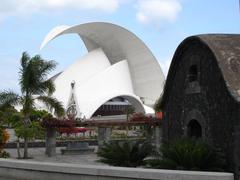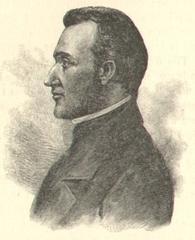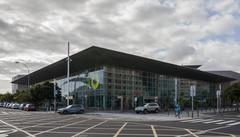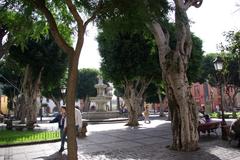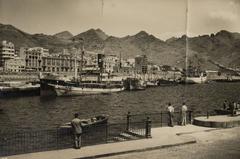
Masonic Temple of Santa Cruz de Tenerife: Visiting Hours, Tickets, and Historical Significance
Date: 04/07/2025
Introduction
Located in the vibrant heart of Santa Cruz de Tenerife, the Masonic Temple stands as one of Spain’s most extraordinary examples of Masonic architecture and an essential landmark within the Canary Islands. With its distinctive Egyptian Revival style, richly symbolic interiors, and storied past, the temple not only reflects the city’s urban evolution but also embodies the enduring legacy and ideals of Freemasonry. Following extensive restoration, it is poised to reopen as a museum and educational center, offering visitors a unique gateway into the world of Masonic tradition, architectural artistry, and the complex history of Tenerife.
Origins and Foundation of the Añaza Lodge
The roots of the Masonic Temple trace back to the late 19th century, during a period of growing Masonic presence in Spain. The Añaza Lodge was officially established on August 8, 1895, becoming a significant force in the Canary Islands’ Masonic movement (canarianfreemasonry.org). Initially under the Grande Oriente Ibérico, the lodge realigned with the Grande Oriente Español in 1903, marking a period of expansion and increased influence throughout the region (wikiwand.com).
Construction and Architectural Significance
Shortly after its foundation, the Añaza Lodge commissioned municipal architect Manuel de Cámara to design a purpose-built temple. Construction began in 1900 and, after years of development, the temple was inaugurated in 1904, though enhancements continued until 1923 (tenerifeweekly.com). The building’s façade, characterized by monumental columns, sphinxes, and the All-Seeing Eye, is laden with Masonic and esoteric symbolism. Notably, the temple’s latitude aligns with the Monastery of Saint Catherine on Mount Sinai, a deliberate choice referencing ancient spiritual traditions (wikiwand.com). Inside, highlights include the main ceremonial hall and the subterranean Chamber of Reflection, a space carved from volcanic rock for Masonic initiation rites (canariasacross.com).
Evolution, Internal Divisions, and Historical Upheaval
The Añaza Lodge’s development was shaped by both growth and internal schisms. After joining the Grande Oriente Español, the lodge eventually became part of the Gran Logia de Canarias during the Primo de Rivera dictatorship, before splitting into two factions in 1931 (wikiwand.com). The main Añaza 270 Lodge continued to use the temple until 1936, when the Spanish Civil War brought repression and confiscation. The building was seized by Francoist authorities, repurposed for military uses, and its archives were transferred to Salamanca, where they remain today.
Decline, Recognition, and Restoration
Following decades of neglect and failed rehabilitation efforts, the temple was acquired by the Santa Cruz City Council in 2001 (wikiwand.com). Recognized for its historical and architectural value, it was declared a Site of Cultural Interest (Bien de Interés Cultural) in 2007 and later designated as a Monument to Historical Memory in 2023 (wikiwand.com). The major restoration project launched in 2021, led by architect María Nieves Febles, is set to revive the temple as a public museum, with meticulous attention to preserving both its symbolic and material heritage (tenerifeweekly.com).
Restoration, Museum Transformation, and Community Engagement
The ongoing restoration—funded by the Spanish government, Canary Islands government, and the city council—represents an investment exceeding three million euros (tenerifeweekly.com). The project not only aims to restore architectural features, such as the ceremonial halls and the Chamber of Reflection, but also to adapt the temple for public use as a museum and research center. Planned features include permanent exhibitions on Freemasonry, a library, and educational programs, all designed to foster greater public understanding of the lodge’s historical role and Masonic symbolism (diariodeavisos.elespanol.com).
Practical Visitor Information
Location and Directions
The Masonic Temple is centrally located at Calle San Lucas, 19, 38002 Santa Cruz de Tenerife. It is easily accessible by public transport, with nearby tram stops and bus lines (Metrotenerife, TITSA). Parking is available in adjacent streets and public garages.
Visiting Hours and Tickets
Upon reopening, the temple will be open Tuesday to Sunday, 10:00 AM to 6:00 PM (last entry 5:30 PM), with guided tours available in Spanish and English. Tickets can be purchased online via the official city website or on site. Standard adult admission is €8.00, with reductions for students, seniors, and children. Advance booking is recommended due to limited group sizes (Santa Cruz de Tenerife Tourism, Ayuntamiento de Santa Cruz de Tenerife).
Accessibility and Amenities
Restoration works prioritize accessibility, including ramps, elevators, and adapted facilities. However, some areas remain challenging for visitors with mobility limitations—contact the temple in advance for guidance. Restrooms, a gift shop, and multilingual signage enhance the visitor experience.
Guided Tours and Special Events
Expert-led guided tours provide insight into Masonic symbolism, history, and architecture. The temple also hosts cultural events, exhibitions, and occasional lectures, often in collaboration with the Grand Lodge of Spain.
Photography and Visitor Etiquette
Photography is allowed in designated areas (no flash or tripods), and visitors are asked to dress modestly and respect the solemnity of the space.
Top Visitor Tips
- Arrive 15 minutes early for tours to ensure smooth check-in.
- Book tickets online to secure your preferred time slot.
- Consult the official website for updates on special events or temporary closures.
- Contact staff in advance for accessibility needs.
Nearby Attractions
Enhance your visit by exploring nearby landmarks such as Plaza de España, the Museum of Nature and Archaeology, García Sanabria Park, and the bustling Rambla de Santa Cruz. Local cafés and markets provide opportunities to experience Santa Cruz’s vibrant culture.
Frequently Asked Questions (FAQ)
Q: When is the Masonic Temple reopening?
A: The temple is scheduled to reopen by mid-2025 following restoration.
Q: How can I purchase tickets?
A: Tickets are available online or at the entrance, but advance booking is recommended.
Q: Are guided tours offered in English?
A: Yes, English-language tours are available—please request when booking.
Q: Is the temple wheelchair accessible?
A: Most areas are accessible, but contact the temple regarding specific needs.
Q: Can I take photos inside?
A: Yes, in designated areas; flash and tripods are not permitted.
Visual Resources
Visitors can preview the experience through virtual tours and images on the official website. High-quality photos with descriptive alt tags help showcase the temple’s architectural and symbolic details.
Contact and Official Information
- Official Website: Ayuntamiento de Santa Cruz de Tenerife – Templo Masónico
- Tourism Office: Plaza de España, s/n, 38003 Santa Cruz de Tenerife, Tel: +34 922 531 628
- Email: [email protected]
Conclusion
The Masonic Temple of Santa Cruz de Tenerife represents a rare confluence of architectural brilliance, symbolic meaning, and historical depth. Its restoration and transformation into a museum reaffirm its status as a beacon of culture, education, and memory in the Canary Islands. Whether you are drawn by its history, architecture, or the mysteries of Freemasonry, the temple offers an enriching and unforgettable experience. Plan your visit, book your tickets in advance, and immerse yourself in the secrets and stories of one of Santa Cruz’s most emblematic sites.


